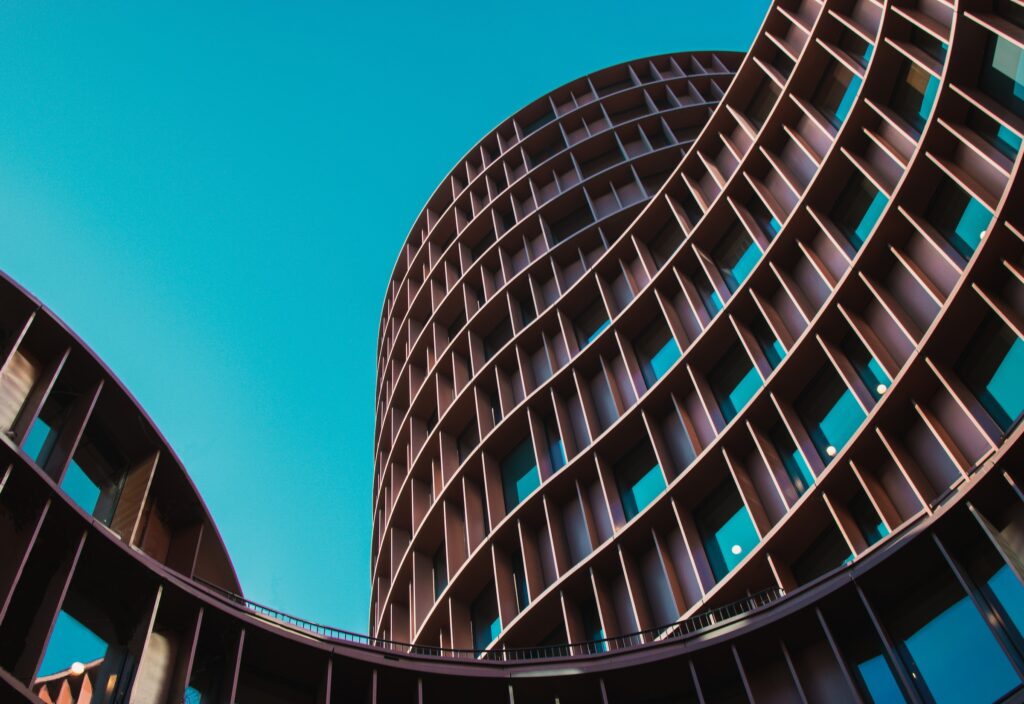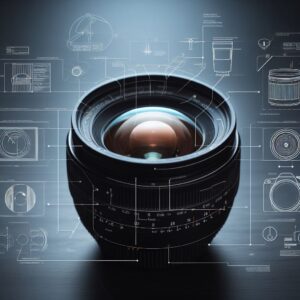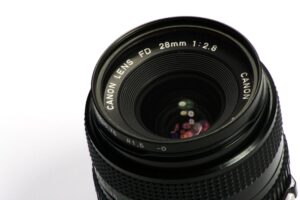Wondering what is a wide angle lens used for in photography? You’re not alone!
Wide-angle lenses are a cornerstone in the toolkit of photographers, both amateur and professional.
These lenses allow you to capture more of the scene in your frame, making them indispensable for various types of photography, from landscapes to architecture.
In this guide, we’ll dive into the different types of wide-angle lenses and provide tips on how to use them effectively.
Note: If you’re new to photography, you might want to check out our beginner’s guide on how camera lenses work.
Exploring the Wide World of Wide-Angle Lenses
The Fish-Eye Perspective
Fish-eye wide-angle lenses are known for their extreme wide-angle view, often capturing up to 180 degrees.
This results in a unique and highly distorted image that can make your photos stand out.
| Characteristics | Popular Models | Applications |
|---|---|---|
| – Extreme wide-angle view (up to 180 degrees) – Distinctive “fish-eye” distortion | – GoPro Hero 9 – Canon EF 8-15mm f/4L Fisheye USM – Nikon AF DX Fisheye-NIKKOR 10.5mm f/2.8G ED | – Action photography – Extreme sports – Creative portraits |
Fish-eye lenses are especially popular in action cameras like GoPros, where the aim is to capture as much of the action as possible.
However, they’re not just for daredevils and adrenaline junkies; creative photographers also use them to add a unique perspective to portraits and landscapes.
Straight Lines and Scenic Views: The Rectilinear Wide-Angle Lenses
Rectilinear wide-angle lenses are your go-to when you want to maintain straight lines in your photos.
Unlike fish-eye lenses, they minimize the curve, making them ideal for capturing architecture and landscapes without distorting the lines.
However, it’s worth noting that some may still exhibit slight barrel distortion.
| Characteristics | Popular Models | Applications |
|---|---|---|
| – Maintains straight lines – May have slight barrel distortion | – Canon EF 16-35mm f/2.8L III USM – Nikon AF-S NIKKOR 14-24mm f/2.8G ED – Sony FE 12-24mm f/4 G | – Architectural photography – Landscape photography |
Tip: If you’re into architectural photography, you might also want to read our guide on what is a telephoto lens used for, as telephoto lenses can also be useful in this genre.
Rectilinear lenses are particularly popular for architectural and landscape photography.
Their ability to maintain straight lines makes them the lens of choice for capturing skyscrapers or scenic vistas without the fish-eye effect.
The Art of Perspective: Tilt-Shift Wide-Angle Lenses
Moving on, let’s talk about tilt-shift wide-angle lenses. These lenses offer a unique feature: the ability to correct perspective distortion.
This is incredibly useful when you’re shooting tall buildings or artworks and want to maintain the correct proportions and angles.
| Characteristics | Popular Models | Applications |
|---|---|---|
| – Corrects perspective distortion | – Canon TS-E 17mm f/4L – Nikon PC-E NIKKOR 24mm f/3.5D ED – Schneider PC-TS Super-Angulon 50mm f/2.8 | – Architectural photography – Fine-art photography |
Tilt-shift lenses are a favorite among professional photographers, especially those specializing in architectural and fine-art photography.
The ability to correct perspective makes these lenses invaluable for capturing buildings and artworks in their true form.
Want to learn more about tilt-shift lenses? Check out our comprehensive guide here.
What Makes a Wide-Angle Lens, Well, Wide? The Key Characteristics
So, you’ve heard about fish-eye, rectilinear, and tilt-shift lenses, but what exactly defines a wide-angle lens? Let’s break it down.
The Focal Length Factor
The popular definition of a wide-angle lens is one with a focal length typically below or equivalent to 35mm.
However, wide-angle lenses can vary in focal lengths, ranging from 35mm down to ultra-wide angles below 16mm.
- 35mm: Often considered the standard for wide-angle lenses.
- 24mm: A popular choice for a moderately wide lens.
- 16mm and below: These are considered ultra-wide angles.
The Sensor Size Impact
Your camera’s sensor size also plays a crucial role in determining the lens’s field of view. A lens might offer a wide-angle view on a full-frame camera but act more like a standard lens on a camera with a smaller sensor.
Note: To delve deeper into how sensor size affects your photography, check out our guide on using an APS-C lens on a full-frame camera.
What to Consider When Choosing a Wide-Angle Lens
When you’re in the market for a wide-angle lens, there are several factors to consider:
- Size and Weight: Especially important for travel photographers.
- Image Quality: Look for lenses with good sharpness and minimal distortion.
- Weather Sealing: A must-have for outdoor photography.
| Consideration | Why It’s Important |
|---|---|
| Size and Weight | Portability for travel and street photography |
| Image Quality | Sharpness, color accuracy, and minimal distortion |
| Weather Sealing | Durability for outdoor and adventure photography |
Unlocking the Potential: Best Uses of Wide-Angle Lenses
Now that you’re familiar with what makes a lens “wide,” let’s explore some of the best uses of wide-angle lenses in various photography genres.
Capturing the Streets: Wide-Angle Lenses in Street Photography

Street photography is all about capturing the essence of everyday life, and what better way to do that than with a wide-angle lens?
These lenses allow you to capture a sense of presence and dramatic perspective, making your street photos come alive.
- Why Wide-Angle Lenses Work for Street Photography:
- Capture more of the scene
- Create a sense of depth and scale
- Allow for close-up shots without invading personal space
- Recommended Prime Lenses for Street Photography:
Tip: If you’re new to street photography, you might also find our guide on best camera lens for sports photography helpful, as some principles of capturing movement can apply here too.
The Traveler’s Companion: Wide-Angle Lenses for Travel Photography

When you’re globetrotting, you’ll want to capture as much of those breathtaking vistas and iconic landmarks as possible.
That’s where wide-angle lenses shine in travel photography.
- Advantages of Using Wide-Angle Lenses for Travel:
- Capture expansive landscapes
- Include more elements in a single frame (great for landmarks!)
- Versatility in various shooting conditions
- Lens Suggestion:
- A moderately wide lens like a 24mm is a versatile choice for travel photography, allowing you to capture both landscapes and tighter shots.
| Consideration | Why It’s Important |
|---|---|
| Expansive Landscapes | Capture the grandeur of natural or urban landscapes |
| Versatility | Useful in a variety of settings, from city streets to mountain ranges |
Building the Frame: Wide-Angle Lenses in Architecture and Real Estate Photography

When it comes to architecture and real estate photography, wide-angle lenses are almost non-negotiable.
These lenses allow you to capture the full essence of buildings, rooms, and spaces, making them appear as grand as they are in real life.
- Why Wide-Angle Lenses are Essential for Architecture and Real Estate:
- Capture entire buildings or rooms in one frame
- Make small spaces appear larger
- Highlight architectural details
- Tilt-Shift for the Win:
- Tilt-shift lenses are particularly useful for keeping vertical lines straight, offering distortion-free results.
The Great Outdoors: Wide-Angle Lenses for Landscape Photography

Landscape photography is another genre where wide-angle lenses truly shine.
They allow you to capture expansive vistas and dramatic landscapes that would be impossible to fit into a single frame with a standard lens.
- Why Wide-Angle Lenses are a Must for Landscape Photography:
- Capture sweeping vistas
- Include foreground interest for a sense of depth
- Work well in confined spaces like canyons or forests
- Lens Spotlight:
- The Canon EF 16-35mm f/4 lens comes highly recommended for landscape photography due to its excellent image quality and versatile focal length range.
| Consideration | Why It’s Important |
|---|---|
| Sweeping Vistas | Capture the grandeur of natural landscapes |
| Foreground Interest | Add depth and dimension to your landscape shots |
In the Thick of It: Wide-Angle Lenses in Event Photography and Photojournalism

When you’re capturing events or reporting from the field, you often have just a split second to get the perfect shot.
That’s why fast and wide lenses are essential for event photography and photojournalism. They allow you to capture a large part of the scene quickly and often without the need for a flash.
- Why Fast and Wide Lenses are Crucial:
- Quick to focus
- Excellent in low-light conditions
- Capture a broad scene in confined spaces
- Wide-Zoom Lenses vs. Wide Aperture Primes:
- Wide-Zoom Lenses: Versatile but may sacrifice some image quality.
- Wide Aperture Primes: Offer better image quality but are less versatile.
Tip: For those of you who are a fan of Sony cameras, don’t miss our guide on the best zoom lens for Sony.
Starry, Starry Night: Wide-Angle Lenses for Night Sky Photography

For those who love to capture the celestial, night sky photography is an exciting frontier, and wide-angle lenses, especially fast primes, are your best friends here.
Lenses like the Sigma 14mm f/1.8 are excellent for capturing expansive star fields and even the Milky Way.
- Why Fast Prime Lenses Work for Night Sky Photography:
- Large aperture allows more light
- Sharp focus on stars
- Wide field of view captures more of the sky
| Consideration | Why It’s Important |
|---|---|
| Large Aperture | Essential for capturing light in low-light conditions |
| Field of View | The wider, the better for capturing expansive star fields |
Thinking Outside the Lens: Alternatives to Wide-Angle Lenses
While wide-angle lenses offer a unique perspective, they’re not the only way to capture a broad field of view.
One popular alternative is stitching techniques, where multiple shots are combined to create a panoramic or wide-angle effect.
- Stitching Techniques Explained:
- Take multiple overlapping photos of a scene.
- Use software to “stitch” the images together.
- Result is a wide-angle view without a wide-angle lens.
- Photographers Who’ve Mastered Stitching:
- Ryan Brenizer is well-known for his “Brenizer Method,” which uses stitching techniques to create a shallow depth of field along with a wide-angle view.
Note: For more creative photography techniques, explore our guide on what is a macro lens used for.
Conclusion
We’ve covered a lot of ground in this guide, from the types of wide-angle lenses to their best uses across various genres of photography.
The versatility and unique capabilities of wide-angle lenses make them an invaluable tool for photographers of all levels.
- Why Wide-Angle Lenses are a Must-Have:
- Versatility in capturing different genres of photography
- Unique perspectives that add a creative touch
- Essential for capturing expansive scenes
| Key Takeaways | Why It’s Important |
|---|---|
| Versatility | Useful in multiple genres of photography |
| Unique Perspectives | Adds creativity and depth to your shots |
| Expansive Scenes | Captures more in the frame for a grander view |
So, whether you’re capturing the sprawling vistas of a mountain range or the intricate details of a bustling city street, wide-angle lenses offer you the creative freedom to see the world in a whole new way.







![Read more about the article Lens Care 101: How Do You Clean a Camera Lens? [2023]](https://photographyexplorer.com/wp-content/uploads/2023/08/How-Do-You-Clean-a-Camera-Lens-300x200.jpg)
